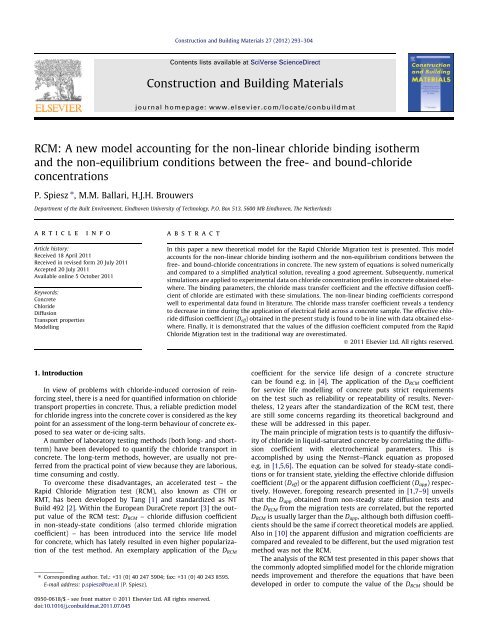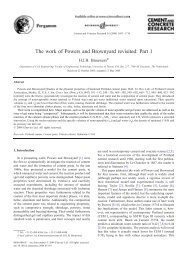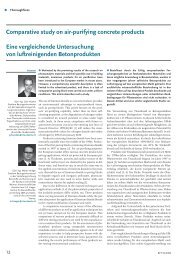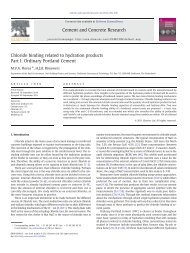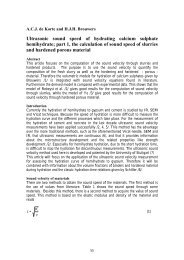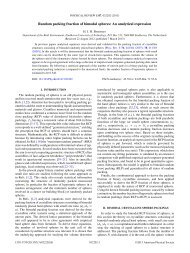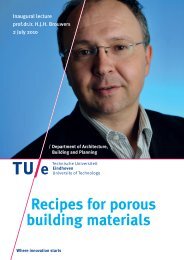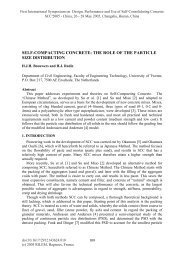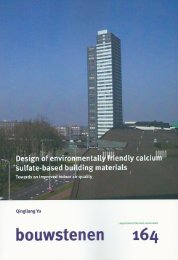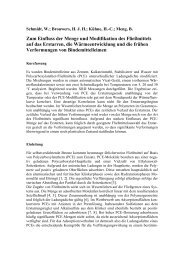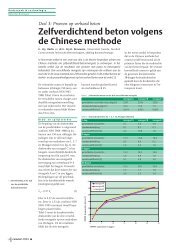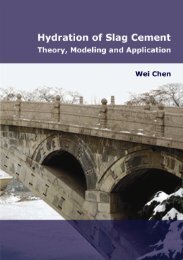RCM: A new model accounting for the non-linear ... - Jos Brouwers
RCM: A new model accounting for the non-linear ... - Jos Brouwers
RCM: A new model accounting for the non-linear ... - Jos Brouwers
You also want an ePaper? Increase the reach of your titles
YUMPU automatically turns print PDFs into web optimized ePapers that Google loves.
<strong>RCM</strong>: A <strong>new</strong> <strong>model</strong> <strong>accounting</strong> <strong>for</strong> <strong>the</strong> <strong>non</strong>-<strong>linear</strong> chloride binding iso<strong>the</strong>rm<br />
and <strong>the</strong> <strong>non</strong>-equilibrium conditions between <strong>the</strong> free- and bound-chloride<br />
concentrations<br />
P. Spiesz ⇑ , M.M. Ballari, H.J.H. <strong>Brouwers</strong><br />
Department of <strong>the</strong> Built Environment, Eindhoven University of Technology, P.O. Box 513, 5600 MB Eindhoven, The Ne<strong>the</strong>rlands<br />
article info<br />
Article history:<br />
Received 18 April 2011<br />
Received in revised <strong>for</strong>m 20 July 2011<br />
Accepted 20 July 2011<br />
Available online 5 October 2011<br />
Keywords:<br />
Concrete<br />
Chloride<br />
Diffusion<br />
Transport properties<br />
Modelling<br />
1. Introduction<br />
abstract<br />
In view of problems with chloride-induced corrosion of rein<strong>for</strong>cing<br />
steel, <strong>the</strong>re is a need <strong>for</strong> quantified in<strong>for</strong>mation on chloride<br />
transport properties in concrete. Thus, a reliable prediction <strong>model</strong><br />
<strong>for</strong> chloride ingress into <strong>the</strong> concrete cover is considered as <strong>the</strong> key<br />
point <strong>for</strong> an assessment of <strong>the</strong> long-term behaviour of concrete exposed<br />
to sea water or de-icing salts.<br />
A number of laboratory testing methods (both long- and shortterm)<br />
have been developed to quantify <strong>the</strong> chloride transport in<br />
concrete. The long-term methods, however, are usually not preferred<br />
from <strong>the</strong> practical point of view because <strong>the</strong>y are laborious,<br />
time consuming and costly.<br />
To overcome <strong>the</strong>se disadvantages, an accelerated test – <strong>the</strong><br />
Rapid Chloride Migration test (<strong>RCM</strong>), also known as CTH or<br />
RMT, has been developed by Tang [1] and standardized as NT<br />
Build 492 [2]. Within <strong>the</strong> European DuraCrete report [3] <strong>the</strong> output<br />
value of <strong>the</strong> <strong>RCM</strong> test: D<strong>RCM</strong> – chloride diffusion coefficient<br />
in <strong>non</strong>-steady-state conditions (also termed chloride migration<br />
coefficient) – has been introduced into <strong>the</strong> service life <strong>model</strong><br />
<strong>for</strong> concrete, which has lately resulted in even higher popularization<br />
of <strong>the</strong> test method. An exemplary application of <strong>the</strong> D<strong>RCM</strong><br />
⇑ Corresponding author. Tel.: +31 (0) 40 247 5904; fax: +31 (0) 40 243 8595.<br />
E-mail address: p.spiesz@tue.nl (P. Spiesz).<br />
0950-0618/$ - see front matter Ó 2011 Elsevier Ltd. All rights reserved.<br />
doi:10.1016/j.conbuildmat.2011.07.045<br />
Construction and Building Materials 27 (2012) 293–304<br />
Contents lists available at SciVerse ScienceDirect<br />
Construction and Building Materials<br />
journal homepage: www.elsevier.com/locate/conbuildmat<br />
In this paper a <strong>new</strong> <strong>the</strong>oretical <strong>model</strong> <strong>for</strong> <strong>the</strong> Rapid Chloride Migration test is presented. This <strong>model</strong><br />
accounts <strong>for</strong> <strong>the</strong> <strong>non</strong>-<strong>linear</strong> chloride binding iso<strong>the</strong>rm and <strong>the</strong> <strong>non</strong>-equilibrium conditions between <strong>the</strong><br />
free- and bound-chloride concentrations in concrete. The <strong>new</strong> system of equations is solved numerically<br />
and compared to a simplified analytical solution, revealing a good agreement. Subsequently, numerical<br />
simulations are applied to experimental data on chloride concentration profiles in concrete obtained elsewhere.<br />
The binding parameters, <strong>the</strong> chloride mass transfer coefficient and <strong>the</strong> effective diffusion coefficient<br />
of chloride are estimated with <strong>the</strong>se simulations. The <strong>non</strong>-<strong>linear</strong> binding coefficients correspond<br />
well to experimental data found in literature. The chloride mass transfer coefficient reveals a tendency<br />
to decrease in time during <strong>the</strong> application of electrical field across a concrete sample. The effective chloride<br />
diffusion coefficient (D eff) obtained in <strong>the</strong> present study is found to be in line with data obtained elsewhere.<br />
Finally, it is demonstrated that <strong>the</strong> values of <strong>the</strong> diffusion coefficient computed from <strong>the</strong> Rapid<br />
Chloride Migration test in <strong>the</strong> traditional way are overestimated.<br />
Ó 2011 Elsevier Ltd. All rights reserved.<br />
coefficient <strong>for</strong> <strong>the</strong> service life design of a concrete structure<br />
can be found e.g. in [4]. The application of <strong>the</strong> D<strong>RCM</strong> coefficient<br />
<strong>for</strong> service life <strong>model</strong>ling of concrete puts strict requirements<br />
on <strong>the</strong> test such as reliability or repeatability of results. Never<strong>the</strong>less,<br />
12 years after <strong>the</strong> standardization of <strong>the</strong> <strong>RCM</strong> test, <strong>the</strong>re<br />
are still some concerns regarding its <strong>the</strong>oretical background and<br />
<strong>the</strong>se will be addressed in this paper.<br />
The main principle of migration tests is to quantify <strong>the</strong> diffusivity<br />
of chloride in liquid-saturated concrete by correlating <strong>the</strong> diffusion<br />
coefficient with electrochemical parameters. This is<br />
accomplished by using <strong>the</strong> Nernst–Planck equation as proposed<br />
e.g. in [1,5,6]. The equation can be solved <strong>for</strong> steady-state conditions<br />
or <strong>for</strong> transient state, yielding <strong>the</strong> effective chloride diffusion<br />
coefficient (Deff) or <strong>the</strong> apparent diffusion coefficient (Dapp) respectively.<br />
However, <strong>for</strong>egoing research presented in [1,7–9] unveils<br />
that <strong>the</strong> Dapp obtained from <strong>non</strong>-steady state diffusion tests and<br />
<strong>the</strong> D <strong>RCM</strong> from <strong>the</strong> migration tests are correlated, but <strong>the</strong> reported<br />
D<strong>RCM</strong> is usually larger than <strong>the</strong> Dapp, although both diffusion coefficients<br />
should be <strong>the</strong> same if correct <strong>the</strong>oretical <strong>model</strong>s are applied.<br />
Also in [10] <strong>the</strong> apparent diffusion and migration coefficients are<br />
compared and revealed to be different, but <strong>the</strong> used migration test<br />
method was not <strong>the</strong> <strong>RCM</strong>.<br />
The analysis of <strong>the</strong> <strong>RCM</strong> test presented in this paper shows that<br />
<strong>the</strong> commonly adopted simplified <strong>model</strong> <strong>for</strong> <strong>the</strong> chloride migration<br />
needs improvement and <strong>the</strong>re<strong>for</strong>e <strong>the</strong> equations that have been<br />
developed in order to compute <strong>the</strong> value of <strong>the</strong> D <strong>RCM</strong> should be
294 P. Spiesz et al. / Construction and Building Materials 27 (2012) 293–304<br />
Nomenclatures<br />
a migration constant (a = zFE/RT) (1/m)<br />
c concentration of chlorides in pore solution<br />
c b<br />
ðg Cl =dm 3<br />
solution Þ<br />
concentration of bound-chlorides ðg Cl =dm 3<br />
solution Þ<br />
cd concentration of chlorides at which 0.1 N AgNO3<br />
changes colour ðgCl =dm 3<br />
solutionÞ cs concentration of chlorides in liquid at liquid–solid interface<br />
ðgCl =dm 3<br />
solutionÞ ct total concentration of chlorides ðgCl =dm 3<br />
solutionÞ c0 concentration of chlorides in bulk solution<br />
ðgCl =dm 3<br />
solutionÞ Cb concentration of bound-chlorides (gCl /gsolid)<br />
Cbi initial concentration of bound-chlorides (gCl /gsolid)<br />
Ct total concentration of chlorides (gCl /gconcrete)<br />
Dapp apparent chloride diffusion coefficient (m 2 /s)<br />
Deff effective chloride diffusion coefficient (m 2 /s)<br />
Df chloride diffusion coefficient in free liquid (m 2 /s)<br />
D<strong>RCM</strong> chloride diffusion coefficient obtained from <strong>the</strong> <strong>RCM</strong><br />
test (Eq. (11)) (m 2 /s)<br />
D chloride diffusion coefficient (m 2 /s)<br />
D0 chloride diffusion coefficient in pore solution of concrete<br />
(m 2 /s)<br />
E electrical field (V/m)<br />
F Faraday constant (C/mol)<br />
i position in time (-)<br />
I imaginary number (–)<br />
j position in concrete (-)<br />
J total flux of chlorides (g s 1 m 2 )<br />
JM flux of chlorides due to migration (g s 1 m 2 )<br />
JD flux of chlorides due to diffusion (g s 1 m 2 )<br />
Jx total flux of chlorides in x direction (g s 1 m 2 )<br />
J0 total flux of chlorides through a unit area of solution<br />
(g s 1 m 2 ) or zero-order Bessel function of <strong>the</strong> first<br />
kind (–)<br />
k chloride mass transfer coefficient (1/s)<br />
Kb<br />
Kd chloride binding capacity (dm 3n /g n )<br />
gravimetric chloride distribution coefficient between liquid<br />
and solid (dm 3 /g)<br />
L thickness of concrete specimen (m)<br />
treated carefully. Thus, <strong>the</strong> objective of this study is to propose an<br />
improved chloride transport <strong>model</strong> in concrete <strong>for</strong> <strong>the</strong> <strong>non</strong>-steadystate<br />
migration test. This <strong>new</strong> <strong>model</strong>, modified with <strong>the</strong> assumptions<br />
of <strong>the</strong> <strong>non</strong>-<strong>linear</strong> chloride binding iso<strong>the</strong>rm and <strong>non</strong>-equilibrium<br />
conditions between chloride concentrations in <strong>the</strong> pore<br />
solution and in <strong>the</strong> solid phase, should be self-consistent and predict<br />
<strong>the</strong> transport of chloride in concrete better.<br />
2. The Rapid Chloride Migration test (NT Build 492 [2])<br />
2.1. Experimental procedure of <strong>the</strong> <strong>RCM</strong> test<br />
The <strong>RCM</strong> test is a <strong>non</strong>-steady-state test, based on <strong>the</strong> ionic migration<br />
induced by an external voltage applied across a concrete specimen<br />
saturated with Ca(OH)2-saturated water solution. The schematic and<br />
actual test set-ups are presented in Fig. 1. Due to <strong>the</strong> potential difference<br />
applied between <strong>the</strong> electrodes, chloride ions move from <strong>the</strong> upstream<br />
solution ( 2mol/dm 3 NaCl solution, hence <strong>the</strong> chloride<br />
concentration in <strong>the</strong> upstream solution is 70.9 g/dm 3 ), through <strong>the</strong><br />
concrete specimen, towards <strong>the</strong> downstream solution (NaOH –<br />
0.3 mol/dm 3 ). The duration of <strong>the</strong> test yields between 6 and 96 h<br />
(depending on <strong>the</strong> quality of <strong>the</strong> concrete expressed in terms of <strong>the</strong> ini-<br />
n chloride binding intensity parameter (–)<br />
r reaction term (1/s g/dm 3 )<br />
R universal gas constant (J mol 1 K 1 )<br />
t time (s)<br />
tM large finite number (s)<br />
t<strong>RCM</strong> duration of <strong>the</strong> <strong>RCM</strong> test (s)<br />
T temperature (K)<br />
u chloride migration velocity (u = zFUDeff/RTL) (m/s)<br />
U voltage (V)<br />
w/c water/cement ratio (–)<br />
x distance (m)<br />
xd chloride penetration depth indicated by AgNO3 (m)<br />
xf inflection point <strong>for</strong> <strong>the</strong> <strong>the</strong>oretical chloride concentration<br />
profile (m)<br />
X dimensionless representative of chloride concentration<br />
in pore solution (–)<br />
Y dimensionless representative of bound-chlorides concentration<br />
(–)<br />
z ion valence (–)<br />
Greek<br />
/ electrical potential (V)<br />
a laboratory constant <strong>for</strong> <strong>the</strong> <strong>RCM</strong> test (–)<br />
v trans<strong>for</strong>med distance (m)<br />
d constrictivity of pore structure (–)<br />
dc compressive strength (MPa)<br />
Dt interval of time (s)<br />
Dx interval of distance (m)<br />
u total water accessible porosity of concrete (–)<br />
k tortuosity of pore structure (–)<br />
C trans<strong>for</strong>med time (s)<br />
qc density of liquid-saturated concrete (g/dm 3 )<br />
qs density of solid state in concrete (g/dm 3 )<br />
s dimensionless representative of time (–)<br />
n dimensionless representative of chloride penetration<br />
front (–)<br />
Special symbols<br />
< > average<br />
tial current value when <strong>the</strong> external voltage is set to 30 V). Afterwards,<br />
<strong>the</strong> specimen is split and sprayed with AgNO3 – a colourimetric indicator<br />
<strong>for</strong> chlorides. Finally, <strong>the</strong> chloride penetration depth is measured<br />
and based on this value <strong>the</strong> D<strong>RCM</strong> is calculated from <strong>the</strong> ma<strong>the</strong>matical<br />
<strong>for</strong>mulas presented in <strong>the</strong> next Section of this paper.<br />
2.2. Current <strong>the</strong>oretical <strong>model</strong> of <strong>the</strong> <strong>RCM</strong> test<br />
The general continuity equation <strong>for</strong> <strong>the</strong> chloride transport in<br />
concrete presents as follows [11]:<br />
@ct<br />
þ urc þ r:J ¼ r ð1Þ<br />
@t<br />
where ct is <strong>the</strong> total chloride concentration in concrete, u <strong>the</strong> velocity<br />
of chloride ion, c <strong>the</strong> concentration of chlorides in pore solution<br />
of concrete, J <strong>the</strong> total flux of chlorides and r is <strong>the</strong> reaction term.<br />
As mentioned be<strong>for</strong>e, <strong>the</strong> chloride ions in migration experiments<br />
are accelerated by <strong>the</strong> electrical field in order to penetrate<br />
<strong>the</strong> saturated concrete specimen with a much higher rate in comparison<br />
to diffusion due to a concentration gradient. The total flux<br />
of chlorides <strong>for</strong> a combined process of diffusion and migration of<br />
ions through saturated and uncharged porous medium is given<br />
by <strong>the</strong> Nernst–Planck equation [1,5,6]:
J x ¼ D @c<br />
@x<br />
zF @/<br />
c<br />
RT @x<br />
; ð2Þ<br />
where D is <strong>the</strong> diffusivity of chloride and / is <strong>the</strong> electrical potential<br />
in <strong>the</strong> direction of x.<br />
Simplifying <strong>the</strong> Nernst–Planck equation (Eq. (2)) with <strong>the</strong><br />
assumption of a constant electrical field distribution across <strong>the</strong><br />
concrete sample, <strong>the</strong> following equation <strong>for</strong> <strong>the</strong> total flux of chlorides<br />
in concrete is given [1]:<br />
J x ¼ J D þ J M ¼ D @c<br />
@x<br />
zFE<br />
c ; ð3Þ<br />
RT<br />
where JD is <strong>the</strong> flux of chlorides due to diffusion, JM <strong>the</strong> flux of chlorides<br />
due to migration and E is <strong>the</strong> electrical field (E=U/L).<br />
Inserting Eq. (3) into <strong>the</strong> continuity equation (Eq. (1)) and<br />
assuming: (a) <strong>the</strong> convection term equal to zero (no pressure gradients<br />
during <strong>the</strong> process); (b) zero reaction term (no change in<br />
mass due to reaction considering <strong>the</strong> whole system) and (c) <strong>the</strong> total<br />
chloride concentration ct defined as ct = c + cb, <strong>the</strong> following<br />
equation is derived <strong>for</strong> <strong>the</strong> chloride transport in concrete in <strong>non</strong>-<br />
steady state conditions [1]:<br />
@c<br />
@t ¼ @J 0<br />
@x<br />
¼ D0<br />
1 þ @c b<br />
@c<br />
@ 2 c<br />
@x 2<br />
zFE<br />
RT<br />
!<br />
@c<br />
¼ D<strong>RCM</strong><br />
@x<br />
@ 2 c<br />
@x 2<br />
zFE<br />
RT<br />
!<br />
@c<br />
@x<br />
: ð4Þ<br />
It is worth to emphasize that in Eq. (4) <strong>the</strong> <strong>linear</strong> chloride binding<br />
iso<strong>the</strong>rm is introduced in <strong>the</strong> D<strong>RCM</strong> coefficient due to <strong>the</strong><br />
assumption of @c b/@c = constant. This assumption is questionable<br />
because <strong>the</strong> binding of chlorides in concrete is <strong>non</strong>-<strong>linear</strong>, <strong>the</strong>re<strong>for</strong>e<br />
<strong>the</strong> term @c b/@c does not have a constant value. Additionally,<br />
<strong>the</strong> above equation represents equilibrium conditions between<br />
free- and bound-chlorides concentrations. These issues will be addressed<br />
later in this paper.<br />
By solving Eq. (4) while applying <strong>the</strong> following initial and<br />
boundary conditions <strong>for</strong> a semi-infinite medium [1]:<br />
c ¼ 0; x > 0; t ¼ 0;<br />
c ¼ c0; x ¼ 0; t > 0;<br />
c ¼ 0; x !1; t ¼ tm;<br />
where c0 is <strong>the</strong> concentration of chlorides in <strong>the</strong> external bulk solution,<br />
<strong>the</strong> following analytical solution is obtained [1]:<br />
cðx; tÞ ¼ c0<br />
2 eax erfc<br />
x þ aD<strong>RCM</strong>t<br />
2 ffiffiffiffiffiffiffiffiffiffiffiffi p þ erfc<br />
D<strong>RCM</strong>t<br />
x aD<strong>RCM</strong>t<br />
ð5Þ<br />
2 ffiffiffiffiffiffiffiffiffiffiffiffi p ; ð6Þ<br />
D<strong>RCM</strong>t<br />
where a = zFE/RT and erfc is <strong>the</strong> complement to <strong>the</strong> error function:<br />
erfc =(1 erf).<br />
P. Spiesz et al. / Construction and Building Materials 27 (2012) 293–304 295<br />
Fig. 1. Rapid Chloride Migration test set-up: (a) schematic and (b) actual.<br />
Assuming that <strong>the</strong> electrical field and <strong>the</strong> chloride penetration<br />
depth are large enough, <strong>the</strong> e ax erfc term on <strong>the</strong> right side tends<br />
to zero, thus Eq. (6) can be simplified to [1]:<br />
cðx; tÞ ¼ c0<br />
2<br />
x aD<strong>RCM</strong>t<br />
erfc<br />
2 ffiffiffiffiffiffiffiffiffiffiffiffi p : ð7Þ<br />
D<strong>RCM</strong>t<br />
In Fig. 2 <strong>the</strong> solution of Eq. (7) is plotted <strong>for</strong> different t, and as<br />
can be seen in this figure, <strong>the</strong> free-chloride concentration changes<br />
rapidly from <strong>the</strong> bulk concentration (c0) to 0 within a short distance<br />
in concrete depth.<br />
It can be found from Eq. (7) that each profile has an inflection<br />
point at x f (see Fig. 2), given in [1] as:<br />
xf ¼ zFE<br />
RT D<strong>RCM</strong>t: ð8Þ<br />
Never<strong>the</strong>less, because <strong>the</strong> value of xf is difficult to determine<br />
experimentally, x d is introduced, representing <strong>the</strong> chloride penetration<br />
indicated by using a colourimetric method. The following<br />
relationship between xf and xd is obtained in [1]:<br />
p<br />
; ð9Þ<br />
xf ¼ xd a ffiffiffiffi<br />
xd<br />
rffiffiffiffiffiffiffiffi<br />
RTL<br />
a ¼ 2<br />
zFU<br />
erf 1 1<br />
2cd<br />
c0<br />
; ð10Þ<br />
where a is <strong>the</strong> laboratory constant, cd is <strong>the</strong> chloride concentration<br />
at which <strong>the</strong> colourimetric indicator changes <strong>the</strong> colour (0.07 mol/<br />
Fig. 2. Theoretical free-chloride concentration profiles in concrete after <strong>the</strong> <strong>RCM</strong><br />
test [1].
296 P. Spiesz et al. / Construction and Building Materials 27 (2012) 293–304<br />
dm 3 or 2.48 g/dm 3 ). Inserting Eq. (9) into Eq. (8) and solving <strong>for</strong> <strong>the</strong><br />
D<strong>RCM</strong> gives as follows [1]:<br />
D<strong>RCM</strong> ¼ RTL xd a<br />
zFU<br />
ffiffiffiffi p<br />
xd<br />
: ð11Þ<br />
t<strong>RCM</strong><br />
The output of <strong>the</strong> test – D<strong>RCM</strong> is a chloride ion transport parameter<br />
in concrete, expressed in m 2 /s and t<strong>RCM</strong> is <strong>the</strong> final duration of<br />
<strong>the</strong> migration test.<br />
2.3. Verification of <strong>the</strong> traditional <strong>the</strong>oretical <strong>model</strong> <strong>for</strong> <strong>the</strong> <strong>RCM</strong> test<br />
As mentioned earlier, an abrupt free-chloride concentration<br />
profile (see Fig. 2) represents <strong>the</strong> solution of <strong>the</strong> chloride transport<br />
<strong>model</strong> developed in [1]. However, in practice it is very difficult to<br />
measure <strong>the</strong> free-chloride concentration profile in concrete, so<br />
usually only <strong>the</strong> total chloride concentration is measured.<br />
Although <strong>the</strong> <strong>the</strong>oretical free- and total chloride concentration profiles<br />
are not equal to each o<strong>the</strong>r when bound-chlorides are present<br />
in concrete, <strong>the</strong>y hypo<strong>the</strong>tically should have <strong>the</strong> same shape if <strong>the</strong><br />
assumptions of <strong>linear</strong> chloride binding iso<strong>the</strong>rm and instantaneous<br />
equilibrium in <strong>the</strong> traditional <strong>RCM</strong> <strong>model</strong> were correct (see Eq.<br />
(4)).<br />
Several researchers have presented <strong>the</strong> experimental total chloride<br />
concentration profiles measured in concrete after <strong>the</strong> migration<br />
tests [1,8,9,12–16]. Table 1 shows <strong>the</strong> concrete mix proportions and<br />
<strong>the</strong> <strong>RCM</strong> test conditions <strong>for</strong> which <strong>the</strong> chloride concentration profiles<br />
were measured by Stanish [12] and Yuan [9]. One of <strong>the</strong>se<br />
<strong>RCM</strong> profiles [9] and an additional natural diffusion test profile<br />
(42 days exposure to chlorides), both measured <strong>for</strong> <strong>the</strong> same concrete<br />
(C4 in Table 1), are shown in Fig. 3. Clearly, <strong>the</strong> reported gradual<br />
experimental profiles after <strong>the</strong> <strong>RCM</strong> test are much different in shape<br />
in comparison to <strong>the</strong> <strong>the</strong>oretical ‘tsunami’ profile presented in Fig. 2,<br />
and very similar in fact to chloride profiles measured in concrete<br />
after natural diffusion exposure to chlorides. This difference between<br />
<strong>the</strong> <strong>the</strong>ory and <strong>the</strong> experimental measurements gives evidence<br />
that <strong>the</strong> current chloride transport <strong>model</strong> <strong>for</strong> <strong>the</strong> <strong>RCM</strong> test<br />
unsatisfactorily describes <strong>the</strong> real process. There<strong>for</strong>e, <strong>the</strong> D <strong>RCM</strong> calculated<br />
based on <strong>the</strong> Eq. (11) should be treated carefully.<br />
Tang in [1] gives a few possible explanations <strong>for</strong> <strong>the</strong> difference<br />
between <strong>the</strong> <strong>the</strong>oretical and experimental chloride profiles, such as<br />
(a) different pore distribution resulting in different penetration<br />
front; (b) reaction kinetics which changes <strong>the</strong> shape of <strong>the</strong> profile<br />
without changing <strong>the</strong> penetration depth or (c) <strong>the</strong> influence of<br />
o<strong>the</strong>r ions on <strong>the</strong> chloride binding. These are sound arguments,<br />
but <strong>the</strong> ef<strong>for</strong>ts taken so far in order to develop a chloride migration<br />
Table 1<br />
Testing conditions and properties of concrete.<br />
Fig. 3. Experimental total chloride concentration profile in concrete after <strong>the</strong><br />
migration and diffusion tests <strong>for</strong> concrete C4 [9].<br />
<strong>model</strong> which predicts well <strong>the</strong> experimental profile (e.g. including<br />
<strong>the</strong> reaction kinetics or developing multi-species <strong>model</strong>s <strong>for</strong> a combined<br />
diffusion-migration process) were unsatisfying. Fur<strong>the</strong>rmore,<br />
o<strong>the</strong>r possible explanations can be added to <strong>the</strong> list.<br />
As previously stated, <strong>the</strong> chloride concentration profile shown<br />
in Fig. 2 results from Eq. (7), in which <strong>the</strong> assumptions of <strong>the</strong> <strong>linear</strong><br />
binding iso<strong>the</strong>rm and equilibrium between free- and bound-chlorides<br />
are introduced. However, as will be explained in <strong>the</strong> next Section,<br />
chloride binding in concrete is a <strong>non</strong>-<strong>linear</strong> process and <strong>the</strong><br />
equilibrium between free- and bound-chlorides cannot be<br />
achieved within such a short period of time as <strong>the</strong> duration of<br />
<strong>the</strong> <strong>RCM</strong> test. There<strong>for</strong>e, <strong>the</strong> authors present a <strong>new</strong> simplified chloride<br />
transport <strong>model</strong>, which can properly predict <strong>the</strong> behaviour of<br />
chlorides migrating into concrete. This <strong>new</strong> <strong>model</strong> includes among<br />
o<strong>the</strong>rs <strong>the</strong> <strong>non</strong>-<strong>linear</strong> binding iso<strong>the</strong>rm and <strong>non</strong>-equilibrium conditions<br />
between free- and bound-chlorides.<br />
3. Chloride binding<br />
When chloride ions penetrate concrete, part of <strong>the</strong>m can be captured<br />
and immobilized by <strong>the</strong> hydration products of cement. This<br />
process of interaction between <strong>the</strong> chloride ions and cement hydrates<br />
– so-called chloride binding – can take place in two ways:<br />
by chemical reaction (with calcium aluminate hydrates) or physical<br />
adsorption (on <strong>the</strong> surface of <strong>the</strong> C–S–H gel). Never<strong>the</strong>less, it<br />
is very difficult in practice to distinguish between <strong>the</strong> chlorides<br />
Concrete code C1 C2 C3 C4 C5<br />
Reference [12] [12] [9] [9] [9]<br />
w/c 0.35 0.45 0.35 0.48 0.60<br />
Cement type T10 T10 Cem I 52.5 N Cem I 52.5 N Cem I 52.5 N<br />
(kg/m 3 ) 418 362.5 400 380 363<br />
Water (kg/m 3 ) 146 163 140 182 218<br />
Coarse aggregates (kg/m 3 ) 1025 1025 1281 1217 1162<br />
Sand (kg/m 3 ) 695 698 660 627 599<br />
Additives Air entrainer, superplasticizer Air entrainer Water reducer – –<br />
rc (56 days) (MPa) 52 33 81.7 46.7 37.9<br />
Age (months) 12–18 12–18 2 2 2<br />
t<strong>RCM</strong> (h) 6, 9 and 18 6, 9 and 18 24 24 24<br />
qc (kg/m 3 ) 2577 2553 2637 2608 2584<br />
qs (kg/m 3 ) 2601 2606 2665 2661 2643<br />
U (V) 60 60 35 25 20<br />
c0 (g/dm 3 ) 70.9 70.9 70.9 70.9 70.9<br />
L (m) 0.05 0.05 0.05 0.05 0.05<br />
u (%) 11.3 14.3 10.2 14.1 15
physically or chemically bound in concrete, thus <strong>the</strong> total amount<br />
of bound-chlorides is usually investigated (e.g. in so called equilibrium<br />
method [1]). It is important to emphasize that only <strong>the</strong> freechlorides<br />
are able to penetrate <strong>the</strong> concrete, which in time may<br />
lead to <strong>the</strong> depassivation of steel rebars, while bound-chlorides<br />
are considered immobilized and harmless to <strong>the</strong> rein<strong>for</strong>cement.<br />
Many extensive reviews regarding <strong>the</strong> binding of chlorides in concrete<br />
can be found in literature e.g. in [17–19].<br />
During <strong>the</strong> migration test not only <strong>the</strong> chlorides but also o<strong>the</strong>r<br />
ions, such as OH , are migrating. This can lead to changes in <strong>the</strong> pH<br />
of <strong>the</strong> pore solution in concrete and some researchers [1,17,20] stated<br />
that binding of chlorides in concrete depends on <strong>the</strong> value of<br />
pH. Never<strong>the</strong>less, <strong>for</strong> sake of simplicity, <strong>the</strong> amount of bound-chlorides<br />
in <strong>model</strong>s <strong>for</strong> <strong>the</strong> transport of chloride in concrete is assumed<br />
as independent from <strong>the</strong> changes in pH.<br />
3.1. Non-<strong>linear</strong> binding of chlorides in concrete<br />
The amount of bound-chlorides increases <strong>non</strong>-<strong>linear</strong>ly with an<br />
increase of <strong>the</strong> free-chlorides concentration and this relationship<br />
is most often described using chloride binding iso<strong>the</strong>rms. Among<br />
<strong>the</strong> binding iso<strong>the</strong>rms <strong>the</strong> most commonly used are <strong>the</strong> iso<strong>the</strong>rms<br />
of Langmuir, Freundlich and BET. The <strong>linear</strong> chloride binding iso<strong>the</strong>rm<br />
does not predict in a proper way <strong>the</strong> relationship between<br />
bound- and free-chlorides: it can be applicable only within a limited<br />
range of free-chlorides concentration [1].<br />
Tang in [1] shows that <strong>the</strong> experimental data <strong>for</strong> <strong>the</strong> chloride<br />
binding in concrete obeys <strong>the</strong> Freundlich iso<strong>the</strong>rm in free-chloride<br />
concentrations in <strong>the</strong> range of 0.01–1 mol/dm 3 (0.35–35.45 g/<br />
dm 3 ), while <strong>the</strong> binding obeys <strong>the</strong> Langmuir iso<strong>the</strong>rm at low Cl<br />
concentrations (
298 P. Spiesz et al. / Construction and Building Materials 27 (2012) 293–304<br />
Additionally, one can assume that <strong>the</strong>re will be instantaneous<br />
equilibrium between <strong>the</strong> concentration of chlorides bound in <strong>the</strong><br />
solid (cement paste) and <strong>the</strong> chlorides in <strong>the</strong> liquid–solid interface.<br />
Thus, such conditions can be described as <strong>non</strong>-equilibrium between<br />
<strong>the</strong> concentrations of chlorides in <strong>the</strong> bulk solution and<br />
bound-chlorides due to <strong>the</strong> liquid–solid mass transfer resistance.<br />
From literature it is known that <strong>the</strong> equilibrium <strong>for</strong> chloride<br />
binding experiments in concrete can be achieved after 7 days [1]<br />
or 10–14 days [23] of exposure. For <strong>the</strong> diffusion tests, <strong>the</strong> assumption<br />
of equilibrium is acceptable since <strong>the</strong> chloride exposure period<br />
is sufficiently long. However, <strong>the</strong> duration of <strong>the</strong> <strong>RCM</strong> test usually<br />
amounts to 24 h and rarely varies from 6 h (<strong>for</strong> poor quality concrete)<br />
up to 4 days (<strong>for</strong> very good quality concrete). This fact is also<br />
pointed out in [14]. There<strong>for</strong>e, during <strong>the</strong> migration process, equilibrium<br />
between free- and bound-chlorides concentrations cannot<br />
be achieved, which implies a necessity of <strong>the</strong> application of <strong>the</strong> Cl<br />
mass transfer rate. The mass transfer rate of chlorides from <strong>the</strong><br />
pore solution, through <strong>the</strong> liquid–solid interface and towards <strong>the</strong><br />
solid, is considered to be induced by a concentration gradient in<br />
<strong>the</strong>se phases.<br />
It is worth to mention that <strong>the</strong> D app obtained from diffusion<br />
tests (e.g. NT Build 443 [24]) and <strong>non</strong>-steady-state migration tests<br />
(NT Build 492 [2]) cannot be equal to each o<strong>the</strong>r because <strong>the</strong><br />
assumption of equilibrium in <strong>the</strong>ir <strong>the</strong>oretical <strong>model</strong>s is fulfilled<br />
<strong>for</strong> <strong>the</strong> diffusion tests, but is not valid <strong>for</strong> <strong>the</strong> <strong>RCM</strong> test.<br />
4. Non-<strong>linear</strong> chloride binding and <strong>non</strong>-equilibrium conditions<br />
during migration<br />
Sometimes researchers state that <strong>the</strong> interaction between chloride<br />
ions and concrete matrix can be ignored, since <strong>the</strong> application<br />
of an electrical field generates an ionic transport rate which is<br />
much faster than <strong>the</strong> kinetics of chemical reactions in concrete or<br />
that <strong>the</strong> exposure time to chloride solution during <strong>the</strong> <strong>RCM</strong> test<br />
is too short. In order to verify this statement, <strong>the</strong> presence of chloride<br />
binding during <strong>the</strong> <strong>RCM</strong> experiments is investigated in this<br />
Section by analyzing some literature data concerning <strong>the</strong> total<br />
chloride concentration profiles in concrete after <strong>the</strong> <strong>RCM</strong> test.<br />
The measurements of chloride concentration profiles are conducted<br />
by flushing concrete dust (from dry-grounded layers of<br />
<strong>the</strong> material) in nitric acid in order to extract <strong>the</strong> chloride ions.<br />
Then <strong>the</strong> concentration of <strong>the</strong> extracted chlorides is measured by<br />
using a chloride-selective electrode or titration method. The measured<br />
value represents <strong>the</strong> total chloride concentration in <strong>the</strong> concrete<br />
sample (Ct), thus consists of both: free- (c) and boundchlorides<br />
(Cb):<br />
Ct ¼ uc þð1 uÞqsCb ; ð13Þ<br />
qc where u is <strong>the</strong> water accessible porosity of concrete, qs <strong>the</strong> density<br />
of solid state of concrete and q c is <strong>the</strong> density of saturated concrete.<br />
If <strong>the</strong>re would be no chloride binding in concrete, Eq. (13) can<br />
be simplified to:<br />
Ct ¼ uc<br />
: ð14Þ<br />
qc During <strong>the</strong> migration process, <strong>the</strong> concentration of chlorides in<br />
<strong>the</strong> pore solution of concrete tends in time to <strong>the</strong> concentration in<br />
<strong>the</strong> bulk solution (c ? c 0 = 70.9 g/dm 3 ). Considering <strong>the</strong> absence of<br />
chloride binding in concrete during <strong>the</strong> migration test, <strong>the</strong><br />
maximum chloride concentration <strong>for</strong> <strong>the</strong> concrete tested by Stanish<br />
[12] (Table 1, concrete C2) amounts to 0.397% ðg Cl =g concreteÞ,<br />
as can be computed from Eq. (14). Never<strong>the</strong>less, as shown in<br />
Fig. 4, <strong>the</strong> measured maximum concentration, about 0.85%<br />
ðg Cl =g concreteÞ, exceeds this value substantially. This effect cannot<br />
Fig. 4. Measured chloride concentration profiles [12] vs. <strong>the</strong>oretical maximum<br />
values.<br />
be explained by a higher porosity than <strong>the</strong> one which was measured<br />
– <strong>for</strong> <strong>the</strong> Cl concentration equal to 0.85% ðg Cl =g concreteÞ <strong>the</strong><br />
water accessible porosity u should exceed 26%, which is an unrealistic<br />
value <strong>for</strong> a conventional concrete. Thus, <strong>the</strong> high total concentration<br />
of chlorides confirms <strong>the</strong> presence of chloride binding.<br />
In order to analyze <strong>the</strong> presence of equilibrium between freeand<br />
bound-chlorides in concrete in <strong>the</strong> case when c 0 concentration<br />
is reached in <strong>the</strong> pore solution (see Fig. 2), <strong>the</strong> maximum boundchloride<br />
concentration (C b) is calculated from Eq. (12) <strong>for</strong><br />
Kb = 0.6 10 3 (dm 3n /g n ) and n = 0.51 (Kb and n extrapolated from<br />
Table 2 <strong>for</strong> concrete), and amounts to 0.0053 ðg Cl =g solidÞ. This maximum<br />
bound-chloride concentration contributes 0.46% to <strong>the</strong> Ct,<br />
applying q s = 2606 g/dm 3 (Table 1). There<strong>for</strong>e, <strong>the</strong> maximum value<br />
of <strong>the</strong> total chloride concentration in concrete (Eq. (13)) implying<br />
equilibrium according to <strong>the</strong> <strong>non</strong>-<strong>linear</strong> binding iso<strong>the</strong>rm (Eq.<br />
(12)), when <strong>the</strong> c0 is reached in <strong>the</strong> pore solution, would yield<br />
0.86% ðg Cl =g solidÞ, as appears in Fig. 4.<br />
In <strong>the</strong> <strong>the</strong>oretical profile shown in Fig. 2 <strong>the</strong> maximum concentration<br />
of chlorides is reached in deeper layers of concrete<br />
too, while in <strong>the</strong> experimental chloride concentration profiles in<br />
Fig. 4 <strong>the</strong> concentration of chlorides decreases gradually along<br />
<strong>the</strong>ir whole length. Also in all <strong>the</strong> o<strong>the</strong>r experimental chloride<br />
profiles presented in [1,8,9,12–16], <strong>the</strong> maximum C t is reached<br />
only at <strong>the</strong> surface of concrete. A possible explanation of this phenome<strong>non</strong><br />
can be <strong>the</strong> absence of equilibrium between free- and<br />
bound-chlorides, because if <strong>the</strong> free-chlorides are not bound<br />
instantaneously <strong>the</strong>y have freedom to penetrate far<strong>the</strong>r into <strong>the</strong><br />
concrete.<br />
5. New chloride transport <strong>model</strong> <strong>for</strong> <strong>the</strong> <strong>non</strong>-steady-state<br />
migration<br />
The main idea of <strong>the</strong> <strong>new</strong> <strong>model</strong> proposed in this paper is an<br />
introduction of <strong>the</strong> <strong>non</strong>-<strong>linear</strong> chloride binding iso<strong>the</strong>rm and<br />
<strong>non</strong>-equilibrium between free- and bound-chlorides concentrations,<br />
in <strong>the</strong> system based on <strong>the</strong> Nernst–Planck equation.<br />
5.1. Governing equations<br />
The simplified Nernst–Planck equation (Eq. (3)) is commonly<br />
used to describe ionic transport in porous medium due to combined<br />
actions of migration and diffusion. However, as showed in<br />
Fig. 5 [25], when a sufficiently large electrical field is applied across
<strong>the</strong> concrete specimen, <strong>the</strong> flux of ions due to electrical migration<br />
(J M) dominates over <strong>the</strong> diffusion flux due to concentration gradients<br />
(JD). The fact that during <strong>the</strong> <strong>RCM</strong> test U = 10–60 V allows simplifying<br />
Eq. (3) to J = J M.<br />
When considering <strong>the</strong> total volume of concrete (solid state and<br />
pores completely saturated with liquid), <strong>the</strong> reaction term in <strong>the</strong><br />
continuity equation (Eq. (1)) is normally set to zero. Never<strong>the</strong>less,<br />
when considering <strong>the</strong> liquid and solid phases separately, <strong>the</strong>re is a<br />
<strong>non</strong>-zero reaction term, because <strong>the</strong> chlorides are transferred from<br />
one phase to ano<strong>the</strong>r. It is assumed that <strong>the</strong> binding of chlorides<br />
takes place instantaneously at <strong>the</strong> surface of <strong>the</strong> hardened cement<br />
paste (i.e. reaction kinetics is not limiting <strong>the</strong> chloride transport so<br />
<strong>the</strong>re is equilibrium between chloride concentration in liquid at liquid–solid<br />
interface and <strong>the</strong> concentration of bound-chlorides),<br />
but <strong>the</strong>re is resistance to <strong>the</strong> mass transfer through <strong>the</strong> liquid–solid<br />
interface. This limitation in <strong>the</strong> mass transfer rate of chlorides is<br />
responsible <strong>for</strong> <strong>the</strong> <strong>non</strong>-equilibrium conditions in <strong>the</strong> system and<br />
is governed by <strong>the</strong> mass transfer coefficient – k. In o<strong>the</strong>r words,<br />
<strong>the</strong> mass transfer rate of chlorides is proportional to <strong>the</strong> deviation<br />
of <strong>the</strong> chlorides concentration in <strong>the</strong> bulk solution from <strong>the</strong> equilibrium<br />
concentration at <strong>the</strong> liquid–solid interface, as given by<br />
<strong>the</strong> Freundlich equation (Eq. (12)). There<strong>for</strong>e, <strong>the</strong> mass transfer<br />
rate reads as follows:<br />
r ¼ kðc csÞ; ð15Þ<br />
where cs interface.<br />
is <strong>the</strong> chloride concentration in liquid at liquid–solid<br />
Calculating cs from Eq. (12) and inserting it into Eq. (15) gives as<br />
follows [26]:<br />
"<br />
r ¼ k c<br />
Cb<br />
#<br />
1=n<br />
: ð16Þ<br />
Kb<br />
From Eqs. (15) and (16) it can be noticed that <strong>the</strong> external chloride<br />
concentration is influencing <strong>the</strong> time needed to reach <strong>the</strong><br />
equilibrium – <strong>for</strong> lower values of c0 <strong>the</strong> initial difference between<br />
<strong>the</strong> c0 and cs is lower as well, so <strong>the</strong> equilibrium between <strong>the</strong>m<br />
can be reached faster.<br />
When assuming: (a) no convection; (b) <strong>the</strong> diffusion rate negligible<br />
in comparison to <strong>the</strong> migration rate; (c) migration of chlorides<br />
only in <strong>the</strong> pore solution of concrete; (d) one dimensional<br />
and constant electrical field distribution across <strong>the</strong> concrete sample;<br />
(e) <strong>non</strong>-<strong>linear</strong> chloride binding iso<strong>the</strong>rm; (f) <strong>non</strong>-equilibrium<br />
between free- and bound-chloride concentrations caused by <strong>the</strong><br />
external liquid–solid mass transfer resistance, which is assumed<br />
to be <strong>the</strong> limiting step <strong>for</strong> <strong>the</strong> chloride transport; (g) <strong>the</strong> binding<br />
parameters (Kb and n) constant during <strong>the</strong> migration and (h) negligible<br />
effect of ionic interactions during <strong>the</strong> migration, <strong>the</strong> continuity<br />
equation (Eq. (1)) <strong>for</strong> liquid and solid phases respectively<br />
reads as follows [26]:<br />
u @c<br />
" #<br />
1=n<br />
@c<br />
Cb<br />
þ u ¼ k c<br />
; ð17Þ<br />
@t @x<br />
@Cb<br />
ð1 uÞqs ¼ k c<br />
@t<br />
Kb<br />
" #<br />
1=n<br />
Cb<br />
; ð18Þ<br />
Kb<br />
where u is <strong>the</strong> ionic migration velocity from Eq. (3), u = DzFU/RTL.<br />
The boundary conditions pertaining to Eqs. (17) and (18) read as<br />
follows:<br />
cðx ¼ 0; tÞ ¼c0;<br />
Cbðx; t ¼ 0Þ ¼Cbi;<br />
ð19Þ<br />
where Cbi is <strong>the</strong> initial bound-chloride concentration in concrete<br />
prior to migration test.<br />
P. Spiesz et al. / Construction and Building Materials 27 (2012) 293–304 299<br />
5.2. Meaning of <strong>the</strong> diffusivity of chlorides adopted in <strong>the</strong> <strong>new</strong> <strong>model</strong><br />
D0 adopted in Tang’s chloride transport <strong>model</strong> <strong>for</strong> <strong>the</strong> <strong>RCM</strong> test<br />
(Eq. (4)) represents <strong>the</strong> diffusion rate of chlorides through <strong>the</strong> pore<br />
solution in concrete and applies only to <strong>the</strong> liquid phase and not<br />
<strong>the</strong> entire volume of concrete. This coefficient can be defined as<br />
[27]:<br />
D0 ¼ Df<br />
d<br />
; ð20Þ<br />
2<br />
k<br />
where D f is <strong>the</strong> diffusion coefficient of chlorides in free liquid (<strong>for</strong><br />
NaCl solution at infinite dilution Df = 2.03 10 9 (m 2 /s), d <strong>the</strong> constrictivity<br />
of pore structure and k is <strong>the</strong> tortuosity of pore structure.<br />
The constrictivity of <strong>the</strong> pore accounts <strong>for</strong> <strong>the</strong> fact that <strong>the</strong> cross<br />
section of a segment varies over its length whereas <strong>the</strong> tortuosity<br />
reflects how <strong>the</strong> pore structure is curved. These two parameters<br />
describing <strong>the</strong> pore structure are difficult to estimate <strong>for</strong> complicated<br />
porous systems (such as concrete), hence <strong>the</strong>y are mostly<br />
used as <strong>the</strong>oretical parameters only.<br />
When applying <strong>the</strong> diffusivity of chlorides in <strong>the</strong> pore solution<br />
of concrete to <strong>the</strong> total volume of concrete, <strong>the</strong> water (chloride)<br />
accessible porosity has to be included, which gives <strong>the</strong> so-called<br />
‘‘effective’’ diffusivity [27]:<br />
Deff ¼ Df<br />
ud<br />
k 2 ¼ uD0: ð21Þ<br />
D eff is commonly determined in steady-state migration or diffusion<br />
techniques. Both diffusion coefficients specified in Eqs. (20) and<br />
(21) are related only to <strong>the</strong> pore structure in concrete and are not<br />
dependent on binding.<br />
On <strong>the</strong> o<strong>the</strong>r hand, <strong>the</strong> apparent diffusion coefficient (D app),<br />
influenced by sorption phenomena, is given by [27]:<br />
Deff<br />
Dapp ¼<br />
u þ Kdqc ; ð22Þ<br />
where K d is <strong>the</strong> gravimetric chloride distribution coefficient defined<br />
as:<br />
Kd ¼ Cb ð1 uÞ q s<br />
c q c<br />
Fig. 5. Migration/diffusion flux ratio <strong>for</strong> U 10 V [25].<br />
ð23Þ<br />
The apparent diffusivity of chlorides (D app) can be derived from<br />
<strong>the</strong> <strong>non</strong>-steady-state diffusion tests (e.g. [24]). The diffusivity of<br />
chlorides obtained from <strong>the</strong> <strong>RCM</strong> test (Eqs. (4) and (11)) in intention<br />
should be equal to <strong>the</strong> Dapp <strong>for</strong> <strong>the</strong> same concrete. Never<strong>the</strong>less,<br />
as explained earlier in this paper, <strong>the</strong>se two diffusion<br />
coefficients are not identical because <strong>the</strong> equilibrium between<br />
free- and bound-chlorides concentrations is achieved only during<br />
<strong>the</strong> diffusion tests.<br />
Analyzing <strong>the</strong> <strong>new</strong> chloride transport <strong>model</strong> presented in this<br />
paper (see Section 5.1) it can be noticed that <strong>the</strong> binding term is<br />
not included in <strong>the</strong> diffusion coefficient (in contradiction to Eqs.
300 P. Spiesz et al. / Construction and Building Materials 27 (2012) 293–304<br />
(4) and (22)), which <strong>the</strong>re<strong>for</strong>e is only related to <strong>the</strong> pore structure<br />
of concrete. Fur<strong>the</strong>rmore, <strong>the</strong> porosity of concrete is applied in <strong>the</strong><br />
equations in order to split <strong>the</strong> total mass balance to liquid and solid.<br />
Thus, in view of coherency, this diffusion coefficient also takes<br />
<strong>the</strong> porosity into account. There<strong>for</strong>e, <strong>the</strong> chloride diffusion coefficient<br />
adopted in <strong>the</strong> <strong>new</strong> chloride transport <strong>model</strong> is <strong>the</strong> effective<br />
diffusivity, as described in Eq. (21).<br />
5.3. Numerical solution<br />
In order to obtain <strong>the</strong> numerical solution of Eqs. (17) and (18) a<br />
<strong>for</strong>ward discretization is per<strong>for</strong>med (according to <strong>the</strong> scheme presented<br />
in Fig. 6) and reads as follows:<br />
u cðiþ1;jÞ cði;jÞ<br />
þ u<br />
Dt<br />
cðiþ1;jþ1Þ cðiþ1;jÞ<br />
Dx<br />
" #<br />
1=n<br />
Cbðiþ1;jÞ<br />
¼ k cðiþ1;jÞ<br />
; ð24Þ<br />
ð1 uÞq s<br />
Kb<br />
Cbðiþ1;jÞ Cbði;jÞ<br />
Dt<br />
" #<br />
1=n<br />
Cbði;jÞ<br />
¼ k cði;jÞ<br />
; ð25Þ<br />
where Dt is <strong>the</strong> interval of time, i is <strong>the</strong> position in time, (i =1...t/<br />
Dt), Dx is <strong>the</strong> interval of distance, j is <strong>the</strong> position in concrete<br />
(j =1...L/Dx).<br />
Solving Eqs. (24) and (25) <strong>for</strong> c (i+1,j+1) and C b(i+1,j) respectively,<br />
gives as follows:<br />
cðiþ1;jþ1Þ ¼ cðiþ1;jÞ<br />
Dx<br />
Cbðiþ1;jÞ ¼ Cbði;jÞ þ<br />
u u cðiþ1;jÞ cði;jÞ<br />
Dt<br />
Dt<br />
k cði;jÞ<br />
qsð1 uÞ<br />
with <strong>the</strong> boundary conditions:<br />
cði;j¼1Þ ¼ c0;<br />
Kb<br />
þ k cðiþ1;jÞ<br />
Cbði;jÞ<br />
Kb<br />
Cbðiþ1;jÞ<br />
Kb<br />
! !<br />
1=n<br />
;<br />
ð26Þ<br />
!<br />
1=n<br />
; ð27Þ<br />
Cbði¼1;jÞ ¼ Cbi: ð28Þ<br />
Fig. 6. Discretization scheme.<br />
5.4. Simplified analytical solution<br />
The system of Eqs. (17) and (18) can be solved analytically <strong>for</strong><br />
zero initial chloride content in concrete (Cbi = 0) and n = 1, i.e. <strong>linear</strong><br />
binding iso<strong>the</strong>rm and <strong>non</strong>-equilibrium conditions. In order to solve<br />
this system a trans<strong>for</strong>mation of variables is adopted as follows:<br />
C ¼ t ux<br />
; ð29Þ<br />
u<br />
v ¼ x; ð30Þ<br />
where v is <strong>the</strong> trans<strong>for</strong>med distance and C is <strong>the</strong> trans<strong>for</strong>med time.<br />
C = 0 corresponds to <strong>the</strong> time needed <strong>for</strong> <strong>the</strong> chloride penetration<br />
front to attain a given position x in <strong>the</strong> concrete.<br />
Trans<strong>for</strong>ming <strong>the</strong> derivatives of t and x and applying Eqs. (29)<br />
and (30) gives as follows:<br />
@ @<br />
¼ ; ð31Þ<br />
@t @C<br />
@ u @ @<br />
¼ þ : ð32Þ<br />
@x u @C @v<br />
Inserting Eqs. (31) and (32) into Eqs. (17) and (18) gives <strong>for</strong> liquid<br />
and solid respectively:<br />
u @c<br />
¼ k c<br />
@v<br />
Cb<br />
Kb<br />
@Cb<br />
ð1 uÞqs ¼ k c<br />
@C<br />
; 0 < v < w; ð33Þ<br />
Cb<br />
Kb<br />
; 0 < C < wu<br />
; ð34Þ<br />
u<br />
where <strong>the</strong> chloride penetration front w = ut/u and <strong>the</strong> pertaining<br />
boundary conditions (invoking Cbi = 0) read as follows:<br />
cðv ¼ 0; CÞ ¼c0<br />
Cbðv; C ¼ 0Þ ¼0:<br />
Introducing <strong>the</strong> following dimensionless variables:<br />
ð35Þ<br />
X ¼ c<br />
; where c0 is <strong>the</strong> maximum free-chloride concentration;<br />
c0<br />
0 6 X 6 1 ð36Þ<br />
Y ¼ Cb<br />
;<br />
Kbc0<br />
where Kbc0 represents <strong>the</strong> maximum bound-chloride<br />
concentration; 0 6 Y 6 1 ð37Þ<br />
n ¼ vk<br />
; ð38Þ<br />
u<br />
s ¼<br />
Ck<br />
Kbð1 uÞq s<br />
; ð39Þ<br />
into Eqs. (33) and (34) gives as follows:<br />
@X<br />
¼ ðX YÞ; ð40Þ<br />
@n<br />
@Y<br />
¼ðX YÞ; ð41Þ<br />
@s<br />
with <strong>the</strong> following boundary conditions:<br />
Xðn ¼ 0; sÞ ¼1<br />
Yðn; s ¼ 0Þ ¼0:<br />
ð42Þ<br />
The analytical solution of Eqs. (40) and (41) applying <strong>the</strong><br />
boundary conditions (Eq. (42)) reads as follows [11]:
Fig. 7. Total chloride concentration profiles generated from analytical and numerical<br />
solutions (n = 1).<br />
X ¼ 1<br />
Z n<br />
0<br />
e ðsþnÞ pffiffiffiffiffiffiffiffi J0ðI 4snÞdn;<br />
ð43Þ<br />
Z s<br />
Y ¼ e ðsþnÞ pffiffiffiffiffiffiffiffi J0ðI 4snÞds;<br />
ð44Þ<br />
0<br />
pffiffiffiffiffiffiffiffi where J0ðI 4snÞ<br />
is <strong>the</strong> zero-order Bessel function of <strong>the</strong> first kind.<br />
For typical experimental conditions during <strong>the</strong> <strong>RCM</strong> test and <strong>the</strong><br />
chloride mass transfer coefficient being <strong>the</strong> limitation of <strong>the</strong> transport<br />
of chlorides (i.e. small values of k) <strong>the</strong> value of <strong>the</strong> Bessel function<br />
yields unity. With this simplification Eqs. (43) and (44) can be<br />
integrated, yielding c and Cb:<br />
c ¼ c0ð1 e s þ e s n Þ; ð45Þ<br />
Cb ¼ c0Kbðe n<br />
e s n Þ: ð46Þ<br />
5.5. Comparison of numerical and analytical solutions<br />
In order to verify <strong>the</strong> validity of <strong>the</strong> numerical solution presented<br />
in Section 5.3, chloride concentration profiles generated<br />
Table 3<br />
Optimized <strong>model</strong> parameters.<br />
P. Spiesz et al. / Construction and Building Materials 27 (2012) 293–304 301<br />
applying both <strong>the</strong> analytical solution (Eqs. (45) and (46)) and<br />
<strong>the</strong> numerical solution (Eqs. (26) and (27)) are compared. The<br />
input parameters used <strong>for</strong> this computation are presented in<br />
Table 1 (<strong>for</strong> C2, t = 18 h). The remaining parameters are selected<br />
as follows: Deff =2 10 12 m 2 /s, Kb = 0.5 10 3 dm 3n /g n , n =1,<br />
k =5 10 6 s 1 , Dx = 0.0001 m, Dt = 1000 s and C bi = 0. The total<br />
chloride concentration profiles resulting from Eqs. (13), (26),<br />
(27), (45), and (46) are presented in Fig. 7. The slight differences<br />
between <strong>the</strong> analytical and numerical chloride concentration profiles<br />
in Fig. 7 can be explained by <strong>the</strong> value of <strong>the</strong> Bessel function<br />
(see Eqs. (43) and (44)), which is assumed to be equal to unity,<br />
but in fact <strong>for</strong> <strong>the</strong> parameters specified above this value may vary<br />
between 1 and 1.2. Never<strong>the</strong>less, <strong>the</strong> agreement is satisfactory,<br />
confirming <strong>the</strong> validity of <strong>the</strong> numerical computation procedure.<br />
There<strong>for</strong>e, <strong>for</strong> fur<strong>the</strong>r computations presented in this paper, <strong>the</strong><br />
numerical solution presented in Eqs. (26) and (27) is applied to<br />
experimental data.<br />
6. Application of <strong>the</strong> <strong>new</strong> <strong>model</strong> to experimental data<br />
As explained be<strong>for</strong>e, <strong>the</strong> <strong>non</strong>-equilibrium conditions and <strong>the</strong><br />
Freundlich binding iso<strong>the</strong>rm are proposed in <strong>the</strong> <strong>new</strong> chloride<br />
migration <strong>model</strong>, introducing <strong>the</strong> values of k, K b and n. Hence, besides<br />
<strong>the</strong> Deff, also <strong>the</strong>se parameters can be derived <strong>for</strong> a particular<br />
concrete.<br />
A wide database of total chloride concentration profiles obtained<br />
on concrete tested using <strong>the</strong> <strong>RCM</strong> test is presented in<br />
[9,12,13]. Besides <strong>the</strong> measured profiles, also many important<br />
<strong>model</strong> parameters are given (Table 1). There<strong>for</strong>e, <strong>for</strong> <strong>the</strong> fur<strong>the</strong>r<br />
investigations presented in this paper, <strong>the</strong> experimental data from<br />
above mentioned references is used.<br />
Based on <strong>the</strong> data presented in Table 1 and on <strong>the</strong> experimental<br />
total chloride concentration profiles [9,12], <strong>the</strong> values of k, K b, n<br />
and Deff are optimized, by using Microsoft Excel Solver (Generalized<br />
Reduced Gradient Algorithm optimization method) and<br />
applying Eqs. (13), (26), and (27). In <strong>the</strong> optimization process <strong>the</strong><br />
values of D eff and k were restrained to be positive. The values of<br />
<strong>the</strong> binding parameters were constrained based on <strong>the</strong> data in<br />
Table 2: n within <strong>the</strong> range of 0.3–0.6 and K b within <strong>the</strong> range<br />
of 0 and 3 10 3 dm 3n /g n . Cbi was set equal to <strong>the</strong> background<br />
Concrete code C1 C1 C1 C2 C2 C2 C3 C4 C5<br />
t<strong>RCM</strong> (h) 6 9 18 6 9 18 24 24 24<br />
Deff ( 10 –12 m 2 /s) 0.85 1.08 0.96 2.04 2.15 1.92 0.55 1.21 2.20<br />
k ( 10 6 1/s) 10.54 7.45 4.55 5.58 5.32 2.10 1.90 1.02 1.05<br />
Kb ( 10 3 dm 3n /g n ) 0.55 0.57 0.61 0.52 0.60 0.56 0.47 0.48 0.37<br />
n 0.53 0.51 0.54 0.52 0.55 0.52 0.48 0.49 0.49<br />
Fig. 8. Optimized total chloride concentration profiles, concrete C1 (Table 1): (a) 6 h; (b) 9 h; (c) 18 h.
302 P. Spiesz et al. / Construction and Building Materials 27 (2012) 293–304<br />
Fig. 9. Optimized total chloride concentration profiles, concrete C2 (Table 1): (a) 6 h; (b) 9 h; (c) 18 h.<br />
Fig. 10. Optimized total chloride concentration profiles, concretes C3, C4 and C5 (Table 1): (a) C3; (b) C4; (c) C5.<br />
concentration measured <strong>for</strong> each analyzed profile. The initial<br />
solutions were selected in <strong>the</strong>ir expected orders of magnitude, as<br />
follows: Deff =1 10 12 m 2 /s, k =1 10 6 1/s, n = 0.5 and<br />
K b = 0.5 10 3 dm 3n /g n . Finally, <strong>the</strong> total mean square error of<br />
<strong>the</strong> relative difference between <strong>the</strong> experimental and simulated total<br />
chloride concentration profiles was minimized by adjusting <strong>the</strong><br />
values of k, Kb, n and Deff. The optimized values of <strong>the</strong> parameters<br />
and simulated chloride profiles are shown respectively in Table 3<br />
and Figs. 8–10.<br />
When analyzing <strong>the</strong> binding coefficients K b and n it can be noticed<br />
that <strong>the</strong> values obtained from <strong>the</strong> numerical <strong>model</strong> (Table 3)<br />
are in a good agreement with <strong>the</strong> values presented in Table 2, measured<br />
by speciation tests. The binding capacity Kb, which determines<br />
<strong>the</strong> maximum amount of bound-chlorides, as expected<br />
from Table 2, is found to be larger <strong>for</strong> concrete containing Cem<br />
T10 (C1, C2) than <strong>for</strong> concrete with Cem I (C3, C4 and C5). This is<br />
due to an increased C3A content in Cem T10; <strong>the</strong> hydration products<br />
of this cement phase are capable of binding more chlorides.<br />
When comparing <strong>the</strong> values of <strong>the</strong> optimized Kb to <strong>the</strong> experimental<br />
data presented in Table 2, it can be seen that <strong>the</strong> values optimized<br />
<strong>for</strong> concrete are about five times lower than obtained on<br />
<strong>the</strong> pastes of similar cements. These values were expected because<br />
<strong>the</strong> volume of <strong>the</strong> paste in concrete is about 1/5, and only <strong>the</strong> paste<br />
can bind chlorides.<br />
The optimum value of n, describing <strong>the</strong> intensity of binding and<br />
<strong>the</strong> maximum amount of bound-chlorides, is found to be in <strong>the</strong><br />
range of 0.48–0.55, which is also in agreement with sorption data<br />
presented in Table 2.<br />
In <strong>non</strong>e of <strong>the</strong> analyzed chloride concentration profiles <strong>the</strong> maximum<br />
total chloride concentration was achieved except <strong>for</strong> <strong>the</strong> surface<br />
layer of concrete, where <strong>the</strong> chloride bearing solution and<br />
concrete are in contact from <strong>the</strong> start of <strong>the</strong> test. This confirms that<br />
<strong>the</strong> assumption of <strong>non</strong>-equilibrium in <strong>the</strong> chloride transport <strong>model</strong><br />
Fig. 11. Simulated chloride concentration profiles, concrete C2, 6 h (Table 1).<br />
presented in this paper is correct. In order to account <strong>for</strong> this phenome<strong>non</strong>,<br />
k, <strong>the</strong> mass transfer coefficient, is introduced (see Section<br />
5.1). The optimized values of k decrease during <strong>the</strong><br />
migration process, which can be observed in Table 3. One can find<br />
in Figs. 8 and 9 that <strong>the</strong> value of k plays a deciding role on <strong>the</strong><br />
shape of each profile. When <strong>the</strong> chloride mass transfer coefficient<br />
is larger, chlorides are bound faster and <strong>the</strong>y do not have so much<br />
freedom to penetrate far<strong>the</strong>r into <strong>the</strong> concrete, which results in a<br />
more abrupt chloride profile (e.g. see in Fig. 8a). However, when<br />
<strong>the</strong> value of k becomes smaller, <strong>the</strong> mass transfer rate of chlorides<br />
becomes <strong>the</strong> limiting factor and <strong>the</strong> profile is characterized by a
Table 4<br />
Comparison of <strong>the</strong> diffusion coefficients.<br />
more gradual shape such as shown e.g. in Figs. 8c and 9c. The<br />
diminishing chloride mass transfer coefficient needs fur<strong>the</strong>r investigations,<br />
since it plays an important role in <strong>the</strong> case of chloride<br />
migration in concrete, and has not been studied yet.<br />
The effective chloride diffusion coefficient, shown in Table 3, is<br />
obtained indirectly – from <strong>the</strong> numerical simulations, while in <strong>the</strong><br />
traditional <strong>RCM</strong> test, <strong>the</strong> D <strong>RCM</strong> is computed according to Eq. (11).<br />
One can notice that <strong>the</strong>re is a clear trend between <strong>the</strong> quality of<br />
concrete expressed in terms of <strong>the</strong> compressive strength (see in<br />
Table 1) and <strong>the</strong> optimized Deff. There is also a relation between<br />
<strong>the</strong> values of <strong>the</strong> D eff and <strong>the</strong> w/c ratio: <strong>the</strong> concrete with low w/c<br />
ratio (C1, C3) has <strong>the</strong> lowest values of Deff and when <strong>the</strong> w/c is<br />
increased (C2, C4 and C5) <strong>the</strong> Deff increases as well. Moreover, <strong>the</strong>se<br />
optimized Deff correspond well with <strong>the</strong> values of <strong>the</strong> diffusion<br />
coefficients presented in [1] <strong>for</strong> concretes with similar w/c ratios,<br />
which were measured in steady-state migration experiments.<br />
In order to obtain <strong>the</strong> values of D<strong>RCM</strong> (Eq. (11)), <strong>the</strong> free-chloride<br />
profiles were simulated and <strong>the</strong>re<strong>for</strong>e <strong>the</strong> free-chloride penetration<br />
depths xd could be estimated. In Fig. 11 examples of <strong>the</strong> simulated<br />
free-, bound- and total chloride concentration profiles are<br />
shown, including <strong>the</strong> penetration depth (xd) which can be indicated<br />
by <strong>the</strong> spraying method. In Fig. 11 also a free- and total chloride<br />
profile, computed <strong>for</strong> a larger value of k (3 10 5 1/s) are shown<br />
in order to simulate <strong>the</strong> chloride profiles shape if <strong>the</strong> equilibrium<br />
could be reached faster. These equilibrium chloride concentration<br />
profiles are similar to <strong>the</strong> <strong>the</strong>oretical abrupt profiles, as can be seen<br />
in Fig. 2. One can also notice that if <strong>the</strong> free-chlorides would be<br />
instantaneously bound in concrete, <strong>the</strong> chloride penetration depth<br />
would be smaller.<br />
Table 4 shows <strong>the</strong> optimized D eff, measured [9] and predicted x d,<br />
D<strong>RCM</strong> calculated according to <strong>the</strong> traditional <strong>model</strong> (Eq. (11)) and<br />
<strong>the</strong> D eff computed from this D <strong>RCM</strong> (Eq. (22), assuming that<br />
D<strong>RCM</strong> = Dapp). The values of Deff calculated from <strong>the</strong> D<strong>RCM</strong> coefficient<br />
are larger than <strong>the</strong> values of D eff optimized from <strong>the</strong> <strong>new</strong> <strong>model</strong>.<br />
This can be explained by <strong>the</strong> fact that when chlorides are not<br />
bound immediately, <strong>the</strong>y have more freedom to penetrate far<strong>the</strong>r<br />
into concrete, as shown in Fig. 11. Thus, <strong>the</strong> traditional <strong>RCM</strong> <strong>model</strong><br />
must give a larger value of <strong>the</strong> D <strong>RCM</strong> coefficient in order to account<br />
<strong>for</strong> this increased penetration depth. Meanwhile, <strong>the</strong> <strong>new</strong> <strong>model</strong><br />
predicts lower values of <strong>the</strong> D eff, which correspond well with data<br />
obtained in steady-state migration tests (e.g. as shown in [1]).<br />
7. Conclusions<br />
The <strong>non</strong>-<strong>linear</strong> chloride binding iso<strong>the</strong>rm and <strong>the</strong> <strong>non</strong>equilibrium<br />
conditions between <strong>the</strong> free- and bound-chlorides are<br />
implemented in <strong>the</strong> <strong>new</strong> <strong>model</strong> <strong>for</strong> <strong>the</strong> <strong>RCM</strong> test. This <strong>model</strong> can predict<br />
<strong>the</strong> chloride transport in concrete better than <strong>the</strong> traditional<br />
<strong>model</strong>. The effective chloride diffusion coefficient as well as <strong>the</strong><br />
binding parameters and <strong>the</strong> chloride mass transfer coefficient can<br />
be estimated from application of this <strong>new</strong> <strong>model</strong> to <strong>the</strong> experimental<br />
data. The values of <strong>the</strong> <strong>non</strong>-<strong>linear</strong> binding parameters (K b and n) extracted<br />
from <strong>the</strong> <strong>new</strong> <strong>model</strong> show good agreement with experimental<br />
data presented in literature, following from sorption studies. The<br />
P. Spiesz et al. / Construction and Building Materials 27 (2012) 293–304 303<br />
Concrete code C1 C1 C1 C2 C2 C2 C3 C4 C5<br />
t<strong>RCM</strong> (h) 6 9 18 6 9 18 24 24 24<br />
Deff ( 10 12 m 2 /s) 0.85 1.08 0.96 2.04 2.15 1.92 0.55 1.21 2.20<br />
xd measured (mm) – – – – – – 14.2 19.3 26<br />
xd computed (mm) 8.5 15.7 26.6 19.3 27.8 47.5 14.7 18.3 27.45<br />
D<strong>RCM</strong> (Eq. (11)) ( 10 12 m 2 /s) 7.52 9.62 8.34 17.91 17.45 15.17 5.59 10.36 19.52<br />
Deff (Eq. (22)) ( 10 12 m 2 /s) 2.14 2.65 2.60 5.22 5.90 4.60 1.26 2.75 4.77<br />
mass-transfer coefficient k features a tendency to decrease in time<br />
during <strong>the</strong> migration test. The effective chloride diffusion coefficient<br />
D eff, obtained from <strong>the</strong> <strong>new</strong> <strong>model</strong>, corresponds well with experimental<br />
data found in literature <strong>for</strong> similar concretes. It has also been<br />
demonstrated that <strong>the</strong> D <strong>RCM</strong> calculated in <strong>the</strong> traditional way is<br />
overestimated.<br />
The most important advantages of <strong>the</strong> <strong>RCM</strong> test are its simple<br />
test procedure, short testing duration and a good repeatability of<br />
results. In future work it will be necessary to interpret <strong>the</strong> <strong>RCM</strong> test<br />
procedure differently in order to calculate <strong>the</strong> diffusivity of chlorides<br />
in a <strong>new</strong> way, but still trying to retain <strong>the</strong>se advantages.<br />
Acknowledgements<br />
The authors wish to express <strong>the</strong>ir gratitude to <strong>the</strong> following<br />
sponsors of <strong>the</strong> Building Materials research group at TU Eindhoven:<br />
Bouwdienst Rijkswaterstaat, Graniet-Import Benelux, Kijlstra<br />
Betonmortel, Struyk Verwo, Attero, Enci, Provincie Overijssel,<br />
Rijkswaterstaat Directie Zeeland, A&G Maasvlakte, BTE, Alvon<br />
Bouwsystemen, V.d. Bosch Beton, Selor, Twee ‘‘R’’ Recycling,<br />
GMB, Schenk Concrete Consultancy, Intron, Geochem Research,<br />
Icopal, BN International, APP All Remove, Consensor, Eltomation,<br />
Knauf Gips, Hess ACC Systems and Kronos (in chronological order<br />
of joining) and to ir. J.J.W. Gulikers, MSc. Q.L. Yu and Dipl. Eng.<br />
M.V.A. Florea <strong>for</strong> <strong>the</strong>ir advice.<br />
References<br />
[1] Tang L. Chloride transport in concrete – measurement and prediction. PhD<br />
<strong>the</strong>sis, Chalmers University of Technology, Go<strong>the</strong>nburg, Sweden, 1996.<br />
[2] NT Build 492. Concrete, mortar and cement-based repair materials: Chloride<br />
migration coefficient from <strong>non</strong>-steady-state migration experiments. Nordtest<br />
method, 1999.<br />
[3] DuraCrete. Probabilistic per<strong>for</strong>mance based durability design of concrete<br />
structures. DuraCrete final technical report, document BE95-1347/R17, 2000.<br />
[4] Breitenbücher R, Gehlen C, Schiessl P, van den Hoonaard J, Siemens T. Service<br />
life design <strong>for</strong> <strong>the</strong> Western Scheldt Tunnel. In: 8th International conference of<br />
building materials and components 3–15, Vancouver, Canada, 1999.<br />
[5] Andrade C. Calculation of chloride diffusion coefficients in concrete from ionic<br />
migration measurements. Cem Concr Res 1993;23:724–42.<br />
[6] Andrade C, Sanjuan MA, Recuero A, Rio O. Calculation of chloride diffusivity in<br />
concrete from migration experiments, in <strong>non</strong> steady-state conditions. Cem<br />
Concr Res 1994;24:1214–28.<br />
[7] Tang L, Sorensen HE. Precision of <strong>the</strong> Nordic test methods <strong>for</strong> measuring <strong>the</strong><br />
chloride diffusion/migration coefficients of concrete. Mater Struct<br />
2001;34:479–85.<br />
[8] Baroghel-Bouny V, Belin P, Maultzsch M, Henry D. AgNO 3 spray test:<br />
advantages, weaknesses, and various applications to quantify chloride<br />
ingress into concrete. Part 2: Non-steady-state migration test and chloride<br />
diffusion coefficients. Mater Struct 2007;40:783–99.<br />
[9] Yuan Q. Fundamental studies on test methods <strong>for</strong> <strong>the</strong> transport of chloride ions<br />
in cementitious materials. PhD <strong>the</strong>sis, University of Ghent, Belgium, 2009.<br />
[10] Castellote M, Andrade C, Alonso C. Measurement of <strong>the</strong> steady and <strong>non</strong>steady-state<br />
chloride diffusion coefficients in a migration test by means of<br />
monitoring <strong>the</strong> conductivity in <strong>the</strong> anolyte chamber. Comparison with natural<br />
diffusion test. Cem Concr Res 2001;31:1411–20.<br />
[11] Bird RB, Stewart WE, Lightfoot EN. Transport phenomena. New York, USA: John<br />
Wiley & Sons Ltd.; 1960.<br />
[12] Stanish KD. The migration of chloride ions in concrete. PhD <strong>the</strong>sis, University<br />
of Toronto, Canada, 2002.<br />
[13] Stanish KD, Hooton RD, Thomas MDA. Prediction of chloride penetration in<br />
concrete, US Department of Transportation. Federal Highway Administration,<br />
FHWA-RD-00-142, 2001.
304 P. Spiesz et al. / Construction and Building Materials 27 (2012) 293–304<br />
[14] Castellote M, Andrade C, Alonso C. Chloride-binding iso<strong>the</strong>rms in concrete<br />
submitted to <strong>non</strong>-steady-state migration experiments. Cem Concr Res<br />
1999;29:1799–806.<br />
[15] Castellote M, Andrade C, Alonso C. Accelerated simultaneous determination of<br />
<strong>the</strong> chloride depassivation threshold and of <strong>the</strong> <strong>non</strong>-stationary diffusion<br />
coefficient values. Corros Sci 2002;44:2409–24.<br />
[16] Gruyaert E, Van den Heede Ph, De Beile N. Chloride ingress <strong>for</strong> concrete<br />
containing blast-furnace slag, related to microstructural parameters. In:<br />
Proceedings of <strong>the</strong> 2nd international RILEM workshop on concrete durability<br />
and service life planning, 440-448, Haifa, Israel, 2009.<br />
[17] Zibara H. Binding of external chlorides by cement pastes. PhD <strong>the</strong>sis,<br />
University of Toronto, Canada, 2001.<br />
[18] Justnes H. A review of chloride binding in cementitious systems. Nord Concr<br />
Res 1998;21:1–6.<br />
[19] Yuan Q, Shi C, De Schutter G, Audenaert K, Deng D. Chloride binding of cementbased<br />
materials subjected to external chloride environment – a review.<br />
Construct Build Mater 2009;23:1–13.<br />
[20] Glass GK, Reddy B, Buenfeld NR. The participation of bound chloride in passive<br />
film breakdown on steel in concrete. Corros Sci 2000;42:2013–21.<br />
[21] Loser L, Lo<strong>the</strong>nbach B, Leemann A, Tuchschmid M. Chloride resistance of<br />
concrete and its binding capacity – comparison between experimental and<br />
<strong>the</strong>rmodynamic <strong>model</strong>ling. Cem Concr Compos 2010;32:34–42.<br />
[22] Green DW, Perry RH. Perry’s chemical engineers’ handbook, 8th ed.; 2007.<br />
[23] Theissing EM, Hest-Wardenier Pv, de Wind G. The combining of sodium<br />
chloride and calcium chloride by a number of different hardened cement<br />
pastes. Cem Concr Res 1978;8:683–92.<br />
[24] NT Build 443. Concrete, hardened: accelerated chloride penetration. Nordtest<br />
method, 1995.<br />
[25] Narsilio GA, Li R, Pivonka P, Smith DW. Comparative study of methods used to<br />
estimate ionic diffusion coefficients using migration tests. Cem Concr Res<br />
2007;37:1152–63.<br />
[26] <strong>Brouwers</strong> HJH. Transport <strong>model</strong> <strong>for</strong> desorption from natural soils packed in<br />
flushed columns. Water Resour Res 1999;35:1771–80.<br />
[27] Atkinson A, Nickerson AK. The diffusion of ions through water-saturated<br />
cement. J Mater Sci 1984;19:3068–78.


